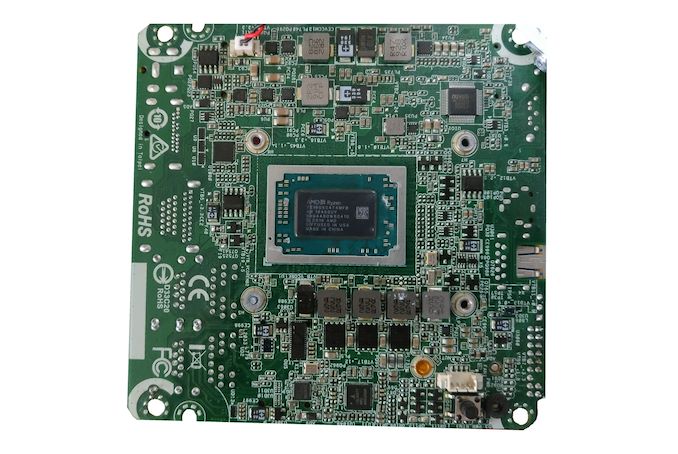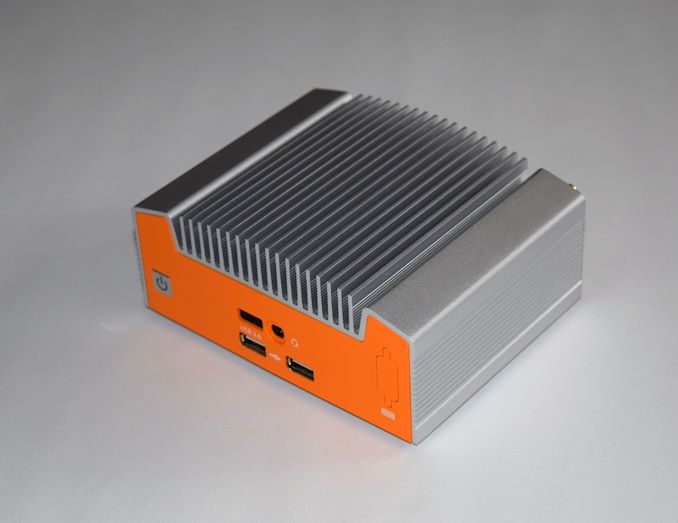ASRock Industrial 4X4 BOX-V1000M Ryzen Mini-PC Review: Finding Zen In The Small Things
by Ganesh T S on September 28, 2020 8:00 AM EST- Posted in
- Systems
- AMD
- NUC
- UCFF
- Ryzen
- Ryzen Embedded
- ASRock Industrial
Concluding Remarks
AMD NUCs such as the ASRock Industrial 4X4 BOX-V1000M represent the first serious non-Intel x86 play in the burgeoning UCFF PC market. Single-board computers (SBCs) have also developed well beyond their embedded markets focus, thanks to the popularity of Raspberry Pi and similar ARM-based kits. x86 has generally played second-fiddle in this market (mainly due to the cost factor).

The Ryzen Embedded V1605B Package
Intel's Atom-class SoCs have made some inroads in this segment, and the Ryzen Embedded series has enabled AMD to join the party. While vendors such as Udoo target the maker market with their Ryzen Embedded SBCs such as the Bolt v8, ASRock Industrial has adopted Intel's approach of selling boards and kits as separate SKUs for the NUCs - the SBC used inside the 4X4 BOX-V1000M (the 4X4-V1000M) is available for standalone purchase by other system integrators and computing solution providers. AMD's partners such as OnLogic have gone ahead and done exactly that to create systems such as the OnLogic ML100G-40.
Consumers finding the performance and characteristics of the 4X4 BOX-V1000M suitable for their applications may require a pre-assembled passively-cooled configuration with ingress protection for deployment. The OnLogic ML100G-40 based on the 4X4-V1000M from ASRock Industrial is a perfect fit for that scenario. It must be noted that the Ryzen Embedded Series and ASRock Industrial / OnLogic's offering comes with a 10-year support cycle - this is important for industrial deployments.
In the preceding sections, we took a detailed look at the internals of the 4X4 BOX-V1000M, and subjected it to a variety of workloads typically run on compact PCs in home / SOHO / industrial environments. Storage and wireless networking benchmarks are usually run as part of our test suite, but not presented in this review because a SATA SSD was used in a slot that also supports NVMe SSDs. Comparing against other systems equipped with NVMe SSDs on the storage subsystem aspect is unlikely to provide any useful information. The Intel Wireless-AC 3168 is also a dated WLAN card (The Wi-Fi 6 AX200 has since taken over as the de-facto WLAN component in most computers today). With theoretical speeds of up to 433 Mbps, the 3168 card seems to have been put in place as a check-box item. In any case, applications requiring the latest wireless standards and peak performance can always replace the Wireless-AC 3168 module with a Wi-Fi 6 card such as the Intel AX200 - Note that only the PCIe version of the card is compatible, and not the CNVIo 2 one.
Overall, the 4X4 BOX-V1000M has given us with the opportunity to evaluate an AMD NUC after a gap of more than six years. In that time frame, AMD has scripted a remarkable turnaround. Due to the HEDT focus (at least on the marketing front) of the first-generation Zen microarchitecture and the resulting Ryzen CPUs, our expectations from the Ryzen Embedded V1605B SoC in the 4X4 BOX-V1000M were modest. In the end, we were pleasantly surprised. That said, the system has both pluses and minuses.
Pros:
- The physical footprint of the system compares very favorably to the existing AMD SFF PCs based on mini-STX boards. The 4X4 and the Intel NUC form-factors are essentially equivalent.
- The chassis design and thermal solution allow for a sustained power consumption of around 22W for the V1605B SoC without any throttling
- The 4X4 BOX-V1000M ships with two gigabit Ethernet ports, auguring well for usage in networking applications
- The system supports three simultaneous 4Kp60 displays - a feature not available in equivalently priced Intel-based NUCs
- The performance-per-dollar aspect is impressive for multi-threaded and graphics workloads compared to the current Intel-based NUCs
Cons:
- There is no support on the motherboard for the commonly-used M.2 2280 SSD form-factor (Only M.2 2242 and 2260 are supported in the available slot), and the chassis design doesn't allow for easy installation of the SODIMMs
- The bundled single-stream Wi-Fi 5 (802.11ac) WLAN card seems like a check-box item. It may have been better to reduce the system cost by not bundling a WLAN component, given that the 4X4-V1000M board has an user-upgradable slot for the same
- The single-threaded performance is a tad disappointing, as is the performance-per-watt metric. However, the newer generation Ryzens are likely to bring better news on this front
- AMD GPU drivers are not the best when it comes to stability
On the drivers aspect, certain popular productivity and creativity programs occasionally crash or hang. Driver updates often fix the issues (and sometimes create new ones in the process). While flaky drivers are the bane for all GPU vendors, it is an unfortunate fact that GPU drivers on AMD-based systems have given us more trouble during SFF PC benchmarking than others. That said, the applications for the Ryzen Embedded series are such that the expected workloads are usually sanitized thoroughly prior to deployment. New drivers are deployed only after qualification. The thermal solution and the PL1 / PL2 performance turbo scheme are tightly coupled aspects not discussed in the above lists - while the thermal solution is excellent in keeping things cool without throttling, the fan noise is not attractive. Recent BIOS updates have apparently modified the fan curves for better user experience. ASRock Industrial has also been conservative in configuring the PL1 / PL2 values. In the case of the Frost Canyon NUC, we saw the instantaneous package power go as high as 42W (with the Core i7-10710U operating in cTDPup mode of 25W). The 4X4 BOX-V1000M goes up to 26W before settling down at 22W. Given that the board is designed for industrial environments with possibly high thermal stress, the conservative approach can't be faulted.
The barebones version of the ASRock Industrial 4X4 BOX-V1000M is available for $390. We have seen it priced as low as $360 previously. All things said, the performance-per-dollar metric is excellent for this first-generation product. ASRock Industrial has already launched the second generation version using Renoir APUs, though its appearance at e-tail outlets is not imminent. Another aspect to consider is that the 4X4-V1000M board has a 10-year support cycle (due to the use of the Ryzen Embedded SoC). The longevity support is not available for the Renoir APU version. In conclusion, exciting times are in store for UCFF PC enthusiasts with the appearance of AMD-based NUCs like the 4X4 BOX-V1000M.











37 Comments
View All Comments
nagi603 - Monday, September 28, 2020 - link
I wish those were intel NICs instead of Realtek, but you can't win all.webdoctors - Monday, September 28, 2020 - link
Love the title, haha.I like the TDP specs of this as I built a low power home nas machine for storing surveillance videos and home automation scripts. But the pricing on this is TERRIBLE. I built a tiny SFF machine for ~$130! It was like $60 for the mobo+CPU, $50 case+PS, $20 RAM etc.
What niche is this thing trying to fulfill?
eastcoast_pete - Monday, September 28, 2020 - link
Thanks for the review, although I would have really liked to see a review of that unit with the 4800u Renoir chip. The long-term support of this unit is, of course, interesting if one deploys them in actual "industrial" settings. However, I strongly assume that most readers here would use a small format PC like this as HTPC at home, and would gladly trade the superior performance of an 8 core Renoir for the "long-term support". So, any chance of seeing that review here?GreenReaper - Monday, September 28, 2020 - link
Why doesn't it use the 10GbE provided by the CPU, even at 1Gbps? Is it a question of power usage? Cost of transceivers? Reliability?eastcoast_pete - Monday, September 28, 2020 - link
10 GbE requires additional hardware (e.g. from Aquantia, or others); the situation is similar for many Intel-based systems. A number of current CPUs are capable of supporting 10 GbE, but all need the additional hardware. In contrast, 2.5 GbE can be implemented w/o adding much to the BOM, so more systems now ship with 2.5 GbE instead of just 1 GbE.GreenReaper - Monday, September 28, 2020 - link
Also, AMD is playing silly buggers with links to its specifications; the one in the article on the model number just leads to a menu page for me. This link has a V1000-series product brief:https://www.amd.com/en/media/42701/download
nicolaim - Monday, September 28, 2020 - link
No USB-C ports on something that's supposed to last up to ten years?PyroHoltz - Monday, September 28, 2020 - link
Good point. Maybe asrock knows something that we don't and usb-c is going to be replaced in the next 5?Lord of the Bored - Wednesday, September 30, 2020 - link
I doubt the target market is going to be plugging any USB-C... whatevers. I think the only things that actually ship with a USB-C connectors are laptop "docks" and USB-grownup-connector adapters.There's literally no benefit to USB-C in this segment.
PeterEvans - Monday, September 28, 2020 - link
Well I guess this is one way to get rid of the three year old laptop parts. Just put them together into a shoebox and call it "innovative". I am surprised it doesn't come with Windows XP.